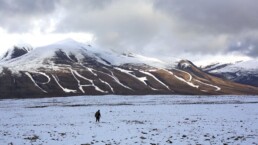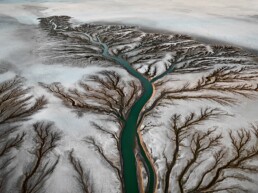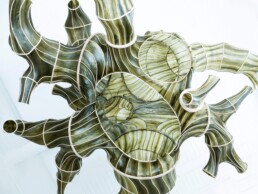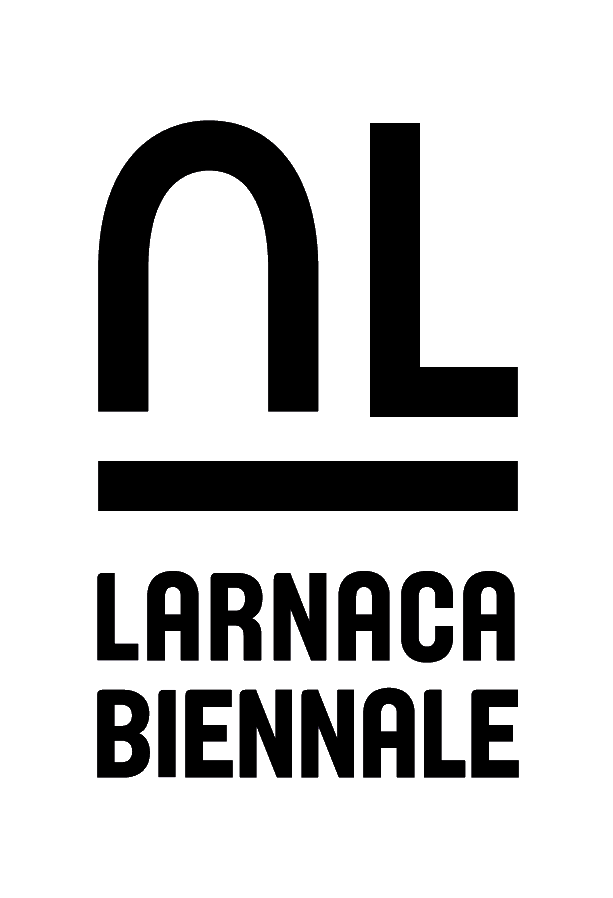by Larnaca Biennale 2023 curator Yev Kravt
We tend to forget that our primal home was once in the natural world – embedded firmly within the environment itself. Home, thus, might also represent a landscape, a forest, or any other wild space. But as we go further into a built environment of houses, streets, neighbourhoods and cities, are we becoming further detached from our origins? This note isn’t just about politics and climate activism, it’s also about listening to the non-human voices of our planet. From the soil to the sea to the sky, each element has its own voice, presence and story. The below reflections serve as a reminded that natural forces should not be overlooked when thinking about the concept of ‘Home away from Home’ – because to forget nature its to forget where we came from.
In the broader lifespan of our planet, human history constitutes only a modest chapter. This revised understanding of humanity reflects not only on the depths of time, but also on the depths of our ecological system. Norwegian philosopher Arne Naess coined the concept of ‘deep ecology’ in 1973, asserting nature as an integral system in which non-human life has the same right to live and flourish as humans. More recently, the German philosopher Peter Sloterdijk declared the end of what he terms ‘backdrop ontology’ – the dominant modern Western perception that has always regarded nature as a tranquil backdrop against which human actions unfold. By challenging this perception, Sloterdijk points out the need for new understandings, where the background becomes the foreground, and where thinking revolves around relationships and interdependencies that shape our existence.
Ideas like these inform parallel movements in other spheres. The Rights of Nature movement, for example, even advocates for non-human life to be granted legal status. But artists also strive to give voice to the landscape; in her film, The People That Is Missing, Spanish multidisciplinary artist Cristina Lucas creates a poem by stringing together quotes from influential thinkers such as James Lovelock and Bruno Latour, as well as Donald Trump and anonymous ‘vox populi’. Their words accompany images of desolate landscapes, sometimes as a voiceover, or project and inscribed in other instances onto the landscape itself. Filmed at the North Pole, in the Svalbard Archipelago – where consequences of the climate crisis are most evident – Lucas’ work emphasises the need to heed the voice of the land.

In works by further artists, it’s the skies and the sea that take centre-stage. By bringing the beauty and transience of clouds into unexpected settings, Bernard Smilde’s Nimbus gives form and substance to the intangible, encouraging us to appreciate the fleeting moments and elusive phenomena that often go unnoticed in our busy lives. Elsewhere, a Dutch collective of artists, designers, and scientists – The Embassy of the North Sea – is committed to elevating the North Sea into a fully-fledged political entity. One of its members, landscape architect Ziega van der Berk, puts theory into practice with her design for a new type of wind farm, conceived to respond to the needs of all non-human life inhabiting these waters. Intended to stimulate the growth of a rich and diverse underwater habitat, Van der Berk’s proposition transforms the sand bar into an artificial reef, creating an undulating surface that supports both the windmills and marine life.

Water is also a focal point of an imposing series by the Canadian photographer Edward Burtynsky. His photographs often focus on industrial landscapes and human interventions in natural spaces, examining humanity’s relationship with water resources. He documents large-scale water systems, such as dams, irrigation channels and aquaculture farms, showcasing both the beauty and the immense scale of these engineered landscapes. By photographing these awe-inspiring scenes, Burtynsky prompts viewers to consider the consequences of our actions on water ecosystems, as well as the need for sustainable water management.

In today’s world, the growing influence of BioDesign is also of note. A remarkable example of its potential applications can be found in the work of designer Julia Lohmann. In 2013, Lohmann founded the Department of Seaweed, a transdisciplinary group of artists, designers, scientists and sea-lovers, all of whom share a goal to develop seaweed into a sustainable material for various future applications. Working with kelp, she embarked on exploring the potential of seaweed in product design. According to Lohmann, “kelp is an ecosystem-builder that supports underwater organisms both big and small, and supplies us with oxygen. It can also provide shelter to the deities of the ocean.”

During the Biennale, we will celebrate the environment and honour the many possible ecological readings of our theme, with contributions from the Larnaca BioDesign Festival among others. The participating artists advocate for an inclusive society that recognises the rights of – and the need for – all living creatures to thrive. They prioritise the welfare of Earth’s future inhabitants, striving to ensure that they are not burdened with the consequences of our actions. In essence, these artists call for a society that nurtures and protects our primal home, respecting the delicate ecosystems of our planet.
Links and mentions from the curator’s note:
– More on Arne Naess’ concept of ‘deep ecology here
– More on Peter Sloterdijks Onthology here
– More on the Embassy of the North Sea here
